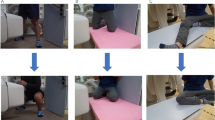Abstract
Although some investigators have referred to the human posterior cruciate ligament (PCL) as the center of the knee, it has received less attention than the more frequently injured anterior cruciate ligament (ACL) and medial collateral ligament (MCL). Therefore, our understanding of the function of the PCL is limited. Our laboratory has developed a method of measuring thein-situ forces in a ligament without contacting that ligament by using a universal force-moment sensor (UFS). In this study, we attached a USF to the tibia and measuredin-situ forces of the human PCL as a function of knee flexion in response to tibial loading. At a 50-N posterior tibial load, the force in the PCL increased from 25±11 N (mean±SD) at 30° of knee flexion to 48±12 N at 90° of knee flexion. At 100 N, the corresponding increases were to 50±17 N and 95±17 N, respectively. Of note, at 30° knee flexion, approximately 45% of the resistance to posterior tibial loading was caused by contact between the tibia and the femoral condyles, whereas, at 90° of knee flexion, no resistance was caused by such contact. For direction of thein-situ force, the elevation angle from the tibial plateau was greater at 30° of knee flexion than at 90° of knee flexion. The data gathered on the magnitude and direction of thein-situ force of the PCL should help in our understanding of the dependence of knee flexion angle of the forces within the PCL.
Similar content being viewed by others
References
Ahmed, A. M., D. L. Burke, N. A. Duncan, and K. H. Chan, Ligament tension pattern in the flexed knee in combined passive anterior tibial translation and axial rotation.J. Orthop. Res. 10:854–867, 1992.
Ahmed, A. M., A. Hyder, D. L. Burke, and K. H. Chan. In-vivo ligament tension patterns in the flexed knee in passive loading.J. Orthop. Res. 5:217–230, 1987.
Barry, D., and A. M. Ahmed. Design and performance of a modified buckle transducer for the measurement of ligament tension.J. Biomech. Eng. 108:149–152, 1986.
Barton, T. M., and J. S. Torg. Posterior cruciate ligament insufficiency: a review of the literature.Am. J. Sports Med. 12:419–430, 1984.
Butler, D. L., F. R. Noyes, and E. S. Grood. Ligamentous restraints to anterior-posterior drawer in the human knee.J. Bone Joint Surg. 62A:259–270, 1980.
covey, D. C., and A. A. Sapega. Current concepts review injuries of the posterior cruciate ligament.J. Bone Joint Surg. 75A:1376–1386, 1993.
France, P. E., A. U. Daniels, M. E. Goble, and H. K. Dunn. Simultaneous quantitation of knee ligament force.J. Biomech. Eng. 16:553–564, 1983.
Fujie, H., G. A. Livesay, S. L.-Y. Woo, and S. Kashiwaguchi. The use of a universal force-moment sensor to determine in-situ forces in ligaments: a new methodology.J. Biomech. Eng. 117:1–19, 1995.
Harner, C. D., G. A. Livesay, S. Kashiwaguchi, and H. Fujie. Comparative study of the size and shape of human anterior and posterior cruciate ligaments.J. Orthop. Res. 13(3):429–434, 1995.
Jasty, M., W. D. Lew, and J. L. Lewis, In-vitro ligament forces in the normal knee using buckle transducersTrans. ORS 7:241, 1982.
Lewis, J. L., W. D. Lew, and J. Schmidt. Note on the application and evaluation of the buckle transducer for knee ligament force measurement.J. Biomech. Eng. 104:125–128, 1982.
Livesay, G. A., H. Fujie, S. Kashiwaguchi, D. A. Morrow, F. H. Fu, and S. L.-Y. Woo. Determination of the in situ forces and force distribution within the human anterior.Ann. Biomed. Eng. 23:467–474, 1995.
Markolf, K. L., D. C. Wascher, and G. A. M. Finerman. Direct in vitro measurement of forces in cruciate ligaments. II. The effect of section of the posterolateral structures.J. Bone Joint Surg. 75A:387–394, 1993.
Race, A., and A. A. Amis. Loading of the two bundles of the posterior cruciate ligament: an analysis of bundle function in A-P drawer.Trans. ORS 19(2):606, 1994.
Vahey, J. W., and L. F. Draganich. Tensions in the anterior and posterior cruciate ligaments of the knee during passive loading: predicting the ligament loads from in-situ measurements.J. Orthop. Res. 9:529–538, 1991.
Wascher, D. C., K. L. Markolf, M. S. Shapiro, and G. A. M. Finerman. Direct in vitro measurement of the forces in cruciate ligaments. I. The effect of multiplane loading in the intact knee.J. Bone Joint Surg. 75A:377–386, 1993.
Author information
Authors and Affiliations
Rights and permissions
About this article
Cite this article
Carlin, G.J., Livesay, G.A., Harner, C.D. et al. In-situ forces in the human posterior cruciate ligament in response to posterior tibial loading. Ann Biomed Eng 24, 193–197 (1996). https://doi.org/10.1007/BF02667348
Received:
Revised:
Accepted:
Issue Date:
DOI: https://doi.org/10.1007/BF02667348




